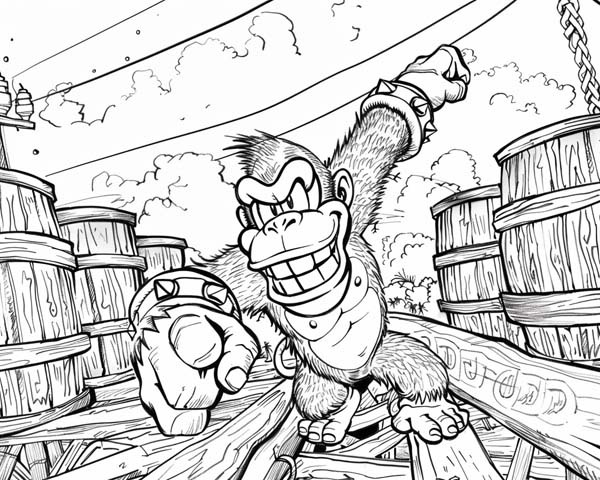Printable Coloring Pages
Donkey Kong Coloring Pages
Welcome to our Donkey Kong coloring pages section!
Swing into the jungle, climb towering structures, and roll through barrels with Donkey Kong and his friends! From daring rescues to wild adventures, these coloring pages capture the fun and excitement of the Donkey Kong series. Whether you’re dodging obstacles, exploring lush landscapes, or teaming up with allies, Donkey Kong offers endless opportunities for playful imagination and adventure.
The Damsels in Distress of Donkey KongThe story of the damsel in distress in Donkey Kong begins in 1981, when a carpenter named Jumpman--who would later be known as Mario--raced up construction sites to rescue a character named Lady, later remembered as Pauline. She was one of the first female characters in video games, serving as the motivating force for the hero’s daring jumps, climbs, and escapes. Pauline’s role was simple but iconic: her presence gave purpose to the gameplay, showing that a story could unfold even in the earliest, most pixelated worlds.
As the series evolved, the damsel archetype shifted. When the Donkey Kong Country series began in 1994, the focus moved to Donkey Kong and his family, with female characters like Candy Kong and Dixie Kong taking on more active roles--helping, sometimes rescuing, and often participating in the adventure rather than just waiting.
In the Mario vs. Donkey Kong games, Princess Peach (originally known as Princess Toadstool) took on the classic “kidnapped” role reminiscent of Pauline, bridging the worlds of Donkey Kong and Mario. Here, the damsel remains a plot driver, but her personality and background enrich the story, showing that even characters placed in peril can have charm, intelligence, and purpose beyond just needing rescue.
The history of Donkey Kong’s damsels reflects the evolution of video game storytelling: from simple motivation for the hero to more nuanced, occasionally playable, or empowered characters. They remind us that even a “classic” trope can carry personality, humor, and history, inspiring new adventures for each generation of players.
The Evolution of Donkey Kong
Donkey Kong began his journey in 1981 as a large, barrel-throwing ape who kidnapped Pauline in the original arcade classic. At first, he was the villain: strong, unpredictable, and full of mischief, challenging Mario (then Jumpman) to climb, dodge, and leap across platforms to rescue the damsel in distress. Despite his role as an antagonist, Donkey Kong’s personality--stubborn, clever, and surprisingly expressive for a few pixels--made him memorable from the very beginning.
As the series grew, Donkey Kong transformed from villain to hero. The Donkey Kong Country series in 1994 reimagined him as a protector of his jungle home, introducing a rich personality, a family, and a cast of allies. Here, Donkey Kong became adventurous, strong, and playful, swinging from vines, rolling through enemies, and showing that power could be paired with heart and humor. His movements and animations added charisma, turning him into a platforming icon and a character players wanted to guide rather than defeat.
Over the years, Donkey Kong has appeared in countless spin-offs and crossovers--from Mario Kart races to Super Smash Bros. battles--each time blending his brute strength with charm and agility. Even in competitive games, he retains his mischievous, larger-than-life energy, balancing his past as a villain with his current heroism.
The evolution of Donkey Kong reflects the broader growth of video game characters: from a simple antagonist in a few pixels to a fully realized hero with personality, story, and style. He reminds players that even characters who start as troublemakers can grow into enduring icons, inspiring adventure, laughter, and imagination for decades.










